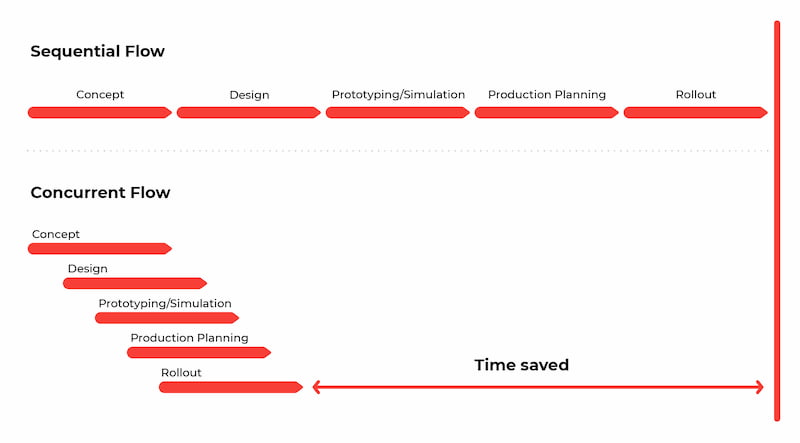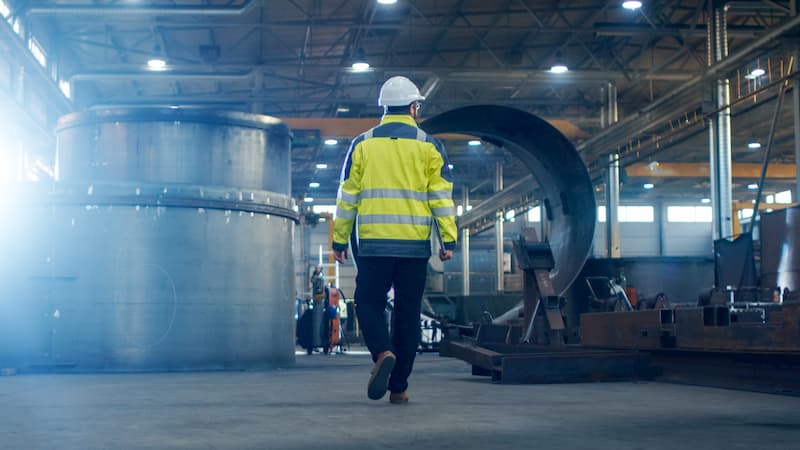The manufacturing and engineering landscape can be pretty competitive. New methods from lean manufacturing to various product design principles are created to gain a slight edge over competitors.
Concurrent engineering is another such example that, like lean manufacturing, derives from Japan. The biggest difference of the two from the origination stand-point is that concurrent engineering was developed solely through engineering practice rather than theoretic ideas.
The concept itself is a few decades old but improvements are being added all the time to raise the efficiency. Let’s see what this practice entails in order to increase profitability and reduce waste.
What Is Concurrent Engineering?
Concurrent engineering or simultaneous engineering is a discipline of integrated product development whereby all the life cycle aspects of a single product are considered simultaneously right from the start. Even at the conceptual phase, engineers are already working on solving everything possible that comes after the product launch.
In concurrent engineering, the various stages in product design (from conception to after-sales support) are approached and analysed, discussed and optimised at the initial stage to prevent undue wastage of time, effort, and money in the long run.
For example, while the design engineers are finalising the product design:
- The marketing team can start creating ad campaigns
- The sales team can create suitable pitches
- The manufacturing team can choose the appropriate production methods
- The supply team can start optimising methods of delivery
- The support team can create the infrastructure for installation and post-sale support
Sequential vs Concurrent Engineering
For comparison, let’s outline the strengths and weaknesses of the traditional sequential engineering method. This systematic approach dictates that only after finishing one stage, the product would be sent to the next stage.

The process is also known as the “over the wall” approach, as each department completes the assigned task and passes it over a hypothetical (or actual) cubicle wall.
With simpler products that don’t require much collaboration and communication, this method works well. The sequential engineering method is also easy to track. Bottlenecks and underperformers can be easily picked out and rectified. A highly complex product line was made simple, fast, and efficient.
But issues always arise. If one of the departments makes a mistake in their assigned task, the product would be sent back over the wall for rectification. This is known as ‘reverse flow’ and is one of the major reasons for its inefficiency.
Elements of Concurrent Engineering
Over time, as products became more and more complex, some of these walls came down naturally due to necessity. More collaboration in product development became imperative to avoid errors that could prove expensive if allowed to occur.
Gradually, as the benefits of this new method became more apparent, smart companies started actively pursuing ways to develop it. Overall, concurrent engineering can be divided into three main elements: people, process and technology.
People
People form the backbone of any organisation. Choosing the right design team at the initial stages of product design concept generation is of paramount importance. The product development in concurrent engineering necessitates that plenary meetings be held of people from different job functions.
The multidisciplinary team meetings are necessary to reduce development time and improve overall product quality. The right team will have a certain set of qualities that promote co-operation, sharing and trust.
Information and feedback sharing by employees must be a regular part of all meetings. Any changes in design or tolerance limits must be conveyed to all concerned departments at the earliest.
The people have to be open to criticism and quick changes. Bringing in different departments at an early stage means that ideas that are knowingly not ripe for production are open for everyone to comment and make suggestions on.
Process
The process is the most important element in concurrent engineering. It defines the different product development stages that must be achieved in order to reach the end goal. Each stage is then further divided and optimised.
As every product and organisation is different, the general philosophy of concurrent engineering must be moulded to fit the project at hand.
Even the most qualified design team will become ineffective and confused if a well-defined process is not put in place. The process refers to the group of different methods used to reach the common goal of the organisation.
The different processes should be capable of functioning in sync so that relevant job functions can keep each other updated about developments and discuss problems should any arise.
Some of the processes that need to be determined are:
- Workflow management and project planning processes
- Quality Function Deployment (QFD) – for translating customer needs to appropriate technical requirements at each development stage
- Design evaluation parameters and methods
- Failure analysis and design modification
Technology
As concurrent engineering requires much more communication and collaboration than the traditional methods, new technologies are necessary to enable and encourage information sharing. There are many amazing technologies available that promote collaboration and instant information sharing.
Any changes requested by a department will be notified to other pertinent departments. The relevant departments, through these technologies, can then collectively assess the impact of these changes on the final design. Alternate iterations can be suggested and easily compared and analysed. Some of these tools are:
- Rapid prototyping technologies
- Project management software for integrated product development
- 3D CAD/CAM tools
- Tools for FEA
- Communication and collaboration technologies
- Failure mode analysis tools
- Personal account manager
- Quality assurance
- Payment terms for companies
- On-time delivery by Fractory
Why Use Concurrent Engineering?
The three most important factors that affect the market share and profitability of an organization are product quality and design, unit cost, and manufacturing lead time. Concurrent engineering (CE) helps companies achieve a competitive edge by improving every one of these factors. Let’s take a look at how this is achieved.
Highly Innovative Solutions
Many times, the skills of employees from different departments overlap. An engineer responsible for shop floor efficiency might have a good eye for aesthetics. A sales executive could have beneficial knowledge regarding design changes that can boost demand from a specific demographic.
Sure, a person whose speciality is in solving a particular issue will have great solutions but since the problem is open for all to see and ponder solutions, valuable input can be obtained from employees who are directly or indirectly affected by it.
Cross-disciplinary meetings take advantage of this fact to identify possible issues and brainstorm solutions that are mutually acceptable. This prevents big mistakes later in the production line, ultimately saving time and money through open information sharing.
Most Modifications Occur in the Initial Stage
Concurrent engineering is developed to identify and resolve issues early on. Every single stage from market research to after-sales support is discussed in the beginning to see how it fits together.
A large number of iterations take place at this stage. These iterations reduce scrap production, minimise the number of future changes, reduce manufacturing lead times, and practically give us the final product control characteristics.
Sequential engineering, on the other hand, goes through a few changes in the initial stages, while many more changes are almost inevitably required later to improve efficiency. These changes have a large impact on the time it takes to bring a new product to the market.
Decreased Risk of Loss
As almost all teams are involved in multiple facets of the product development process, there is more overlap. More than one person has the necessary information about the new product and its life cycle.
Therefore, losing a single employee does not bear a large risk on the overall success of the project. Also, adding new members is easier because of the free flow of information.
Shorter Time-to-Market

This is probably the biggest win that concurrent engineering has to offer. By working on many facets of the project simultaneously, there is a lot of time to be saved. This can result in a significant advantage over competitors by entering the market with a new product earlier.
Challenges of Concurrent Design
In order to successfully implement concurrent design, one needs to know about the challenges that come across product managers. An adequate understanding of these barriers can help reduce or completely eliminate them. When it comes to concurrent engineering, the two main barriers are organisational and technical.
Organisational barrier refers to the management style, values, and culture. These can be improved upon with sufficient training of the workforce.
The technical barrier refers to the lack of technological resources for effective data sharing and communication. The following challenges need addressing in order to successfully implement concurrent design:
- Workforce training and skill development
- Insufficient support from management
- Impractical schedules
- Unreasonable reward systems
- Lack of IT tools
- Insufficient knowledge and expertise in concurrent engineering application
- Lack of proper coordination among team members
Tips for Implementation
A great thing about concurrent engineering is that any organisation can start implementing it right away. All that’s needed is more inclusion.
When a new project starts, invite the entire product development team associated with the project. After the first meeting, for every follow-up meeting regarding project specifics, invite all the concerned departments that have a stake in the meeting’s outcome.
Tools for communication and data sharing must be gradually introduced so that everyone is on the same page when it comes to any new developments in the product design. Any problems arising in different departments must be identified early on and discussed in general team meetings to find feasible solutions.
Common Misconceptions
There are a few reasons why companies are reluctant to adopt concurrent engineering principles. While some of the reasons are definitely valid, we bring out the common misunderstandings regarding the concurrent design and engineering discipline that halt the adoption of this method.
Everyone Must Attend Meetings All the Time
This is not true. It is prudent to call only those employees whose work will be affected by the agenda of the meeting. Of course, it is also wise to include employees whose experience and expertise in their field could provide valuable input and steer the meeting towards a more beneficial outcome. To avoid meeting fatigue and improve efficiency, some teams adopt asynchronous meetings, which enable members to contribute at their own pace while maintaining alignment on goals and decisions.
Individual Job Responsibilities Don’t Exist
Individual job functions still exist and a person is responsible for doing the assigned work. People will only be collaborating more often and all team members will provide input during the decision-making sessions.
No Sequence to Things
Concurrent design does not obviate the need for sequential product development. Concurrent engineering states that if tasks can be done simultaneously, they should.
Obviously, we cannot design repair kits for a product before finalising the product design itself. But we can start designing the repair kits before the product is fully designed. Wherever practical, tasks must be carried out concurrently but some tasks will naturally have to be completed before others.
Conclusion
While concurrent engineering (CE) was initially conceptualised for the manufacturing industry, its use has recently been extended to the development and maintenance services as well.
The systematic approach in simultaneous engineering promotes the use of integrated product development methods. These methods are known for promoting innovation.
Getting a new product right the first time with a short time-to-market duration is a hallmark of concurrent engineering. It is a robust philosophy that invariably improves the overall product quality despite the many challenges to its successful implementation.



